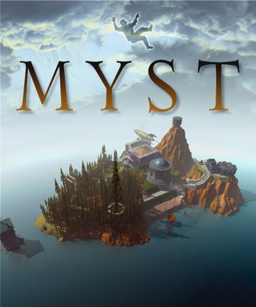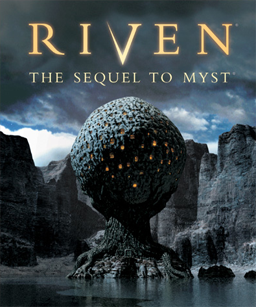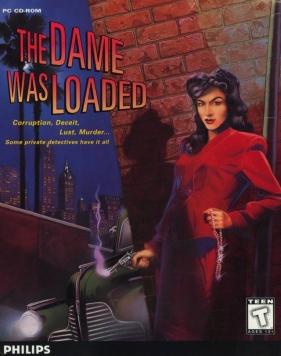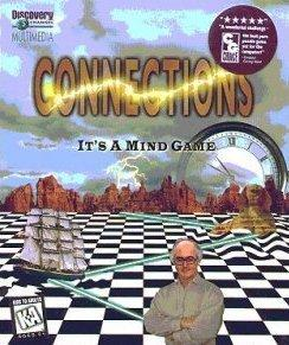
Starship Titanic is an adventure game developed by The Digital Village and published by Simon & Schuster Interactive. It was released in April 1998 for Microsoft Windows and in March 1999 for Apple Macintosh. The game takes place on the eponymous starship, which the player is tasked with repairing by locating the missing parts of its control system. The gameplay involves solving puzzles and speaking with the bots inside the ship. The game features a text parser similar to those of text adventure games with which the player can talk with characters.

Myst is an adventure video game designed by Rand and Robyn Miller. It was developed by Cyan, Inc., published by Broderbund, and first released in 1993 for the Macintosh. In the game, the player travels via a special book to a mysterious island called Myst. The player interacts with objects and traverses the environment by clicking on pre-rendered imagery. Solving puzzles allows the player to travel to other worlds ("Ages"), which reveal the backstory of the game's characters and help the player make the choice of whom to aid.

Return to Zork is a 1993 graphic adventure game in the Zork series. It was developed by Activision and was the final Zork game to be published under the Infocom label.

Riven: The Sequel to Myst is a puzzle adventure video game, the second in the Myst series of games. Developed by Cyan Worlds, it was initially published by Red Orb Entertainment, a division of Broderbund. Riven was distributed on five compact discs and released for Mac and Windows personal computers on October 31, 1997, in North America; it was later released on a single DVD-ROM in 1998. Riven was also ported to several other platforms. The story of Riven is set after the events of Myst. Having been rescued from the efforts of his sons, Atrus enlists the help of the player character to free his wife from his power-hungry father, Gehn. Riven takes place almost entirely on the Age of Riven, a world slowly falling apart due to Gehn's destructive rule.

Uru: Ages Beyond Myst is an adventure video game developed by Cyan Worlds and published by Ubisoft. Released in 2003, the title is the fourth game in the Myst canon. Departing from previous games of the franchise, Uru takes place in the modern era and allows players to customize their onscreen avatars. Players use their avatars to explore the abandoned city of an ancient race known as the D'ni, uncover story clues and solve puzzles.

Myst III: Exile is the third title in the Myst series of graphic adventure puzzle video games. While the preceding games in the series, Myst and Riven, were produced by Cyan Worlds and published by Brøderbund, Exile was developed by Presto Studios and published by Ubi Soft. The game was released on four compact discs for both Mac OS and Microsoft Windows on May 8, 2001; versions for the Xbox and PlayStation 2 were released in late 2002. A single-disc DVD version was later released for Windows and Mac OS.

Myst IV: Revelation is a 2004 adventure video game, the fourth installment in the Myst series, developed and published by Ubisoft. Like Myst III: Exile, Revelation combines pre-rendered graphics with digital video, but also features real-time 3D effects for added realism. The plot of Revelation follows up on plot details from the original Myst. The player is summoned by Atrus, a man who creates links to other worlds known as Ages by writing special linking books. Almost twenty years earlier, Atrus' two sons nearly destroyed all of his books and were imprisoned; Atrus now wishes to see if his sons' imprisonment has reformed them. The player travels to each brother's prison, in an attempt to recover Atrus' daughter Yeesha from the brothers' plot.

Pyst is an adventure computer game released in October 1996. It was created as a parody of the highly successful adventure game Myst. Pyst was written by Peter Bergman, a co-founder of the Firesign Theatre, and was published by Parroty Interactive, with Bergman, Stallone, Inc. as co-publisher. Mindscape began distributing the game on August 20, 1997. The parody features full motion video of actor John Goodman as "King Mattruss", the ruler of "Pyst Island". Versions of the game were produced for both the Windows PC and Apple Macintosh operating systems.
Myst is a franchise centered on a series of adventure video games. The first game in the series, Myst, was released in 1993 by brothers Rand and Robyn Miller and their video game company Cyan, Inc. The first sequel to Myst, Riven, was released in 1997 and was followed by three more direct sequels: Myst III: Exile in 2001, Myst IV: Revelation in 2004, and Myst V: End of Ages in 2005. A spinoff featuring a multiplayer component, Uru: Ages Beyond Myst, was released in 2003 and followed by two expansion packs.

Myst V: End of Ages is a 2005 adventure video game, the fifth installment in the Myst series. The game was developed by Cyan Worlds, published by Ubisoft, and released for Macintosh and Windows PC platforms in September 2005. As in previous games in the series, End of Ages's gameplay consists of navigating worlds known as "Ages" via the use of special books and items which act as portals.

Atlantis: The Lost Tales is a 1997 fantasy adventure video game developed and published by Cryo Interactive Entertainment. Interplay Productions published the game in North America, where it released on September 30, 1997. The game is named after its initial and most important setting, Atlantis. It is the first in a Myst-like series, and was followed by Atlantis II, Atlantis III: The New World, Atlantis Evolution and The Secrets of Atlantis: The Sacred Legacy.

Amber: Journeys Beyond is an American computer game released in 1996 for Apple Macintosh computers and Windows 95. It is the only game produced by Hue Forest Entertainment, founded by Frank and Susan Wimmer.

Timelapse is a 1996 graphic adventure game developed and published by GTE Entertainment. Inspired by the game Myst, it tasks the player with the rescue of an archaeologist trapped in another dimension. The player navigates a series of time portals to locations such as ancient Egypt, Maya and the prehistoric Puebloan civilization, while solving puzzles and searching for clues to the archaeologist's whereabouts.

The Dame Was Loaded is a first-person point-and-click adventure game for MS-DOS and Macintosh created by Australian developer Beam Software. It was published in 1996 by Philips Interactive Media.

Jewels of the Oracle is a 1995 adventure game developed by ELOI Productions and published by Discis Knowledge Research Inc. It was released on Macintosh, PlayStation, Sega Saturn, and Windows. A sequel developed by Bardworks and published by Hoffman and Associates was released in 1998 entitled Jewels II: The Ultimate Challenge.

Pilgrim: Faith as a Weapon is a 1997 adventure video game, written by Paulo Coelho, who wrote The Pilgrimage, the novel on which the game is based. Pilgrim has been described as a "commercial cultural heritage game" and "graphic interactive fiction". It is the premiere title of Arxel Tribe and the first in an adventure trilogy, which also includes The Legend of the Prophet and the Assassin (1999) and The Secrets of Alamut (2001).

The Legend of the Prophet and the Assassin is an adventure game by Arxel Tribe. It is the sequel to Pilgrim: Faith as a Weapon. It was released in October 2000 for Windows. The game is inspired by the work of Brazilian novelist Paulo Coelho. A sequel, The Secrets of Alamût was released in March 2001.

Connections is a 1995 educational adventure video game.

Physicus: Save the World with Science! is a 1999 educational adventure video game developed by Ruske & Pühretmaier Edutainment and published by Heureka-Klett-Softwareverlag and Tivola Entertainment. It aims to teach players about physics concepts. It is part of a series that includes the chemistry-themed Chemicus and biology-themed sequel Bioscopia. It was the second learning adventure game by Ruske & Pühretmaier after the music-based Opera Fatal. The game's website had a minigame called "PHYSICO DriveIn" that players could download and complete in to get the highscore, which would win them a free copy of a game by the studio. A sequel entitled Physicus: The Return was later released, and was remade for the iOS.

Reah: Face the Unknown, known in North America as simply Reah, is a 1998 first-person puzzle-oriented adventure game with a non-linear plot, described as a Myst-clone. It was developed by Project Two Interactive / Black Friar and published by Detalion and LK Avalon. It was distributed by Erbe in Spain on October 10, 1998. It was published by Project 2 Interactive in the Netherlands, and distributed in the U.S. and Canada by GT Interactive in 1999.



















